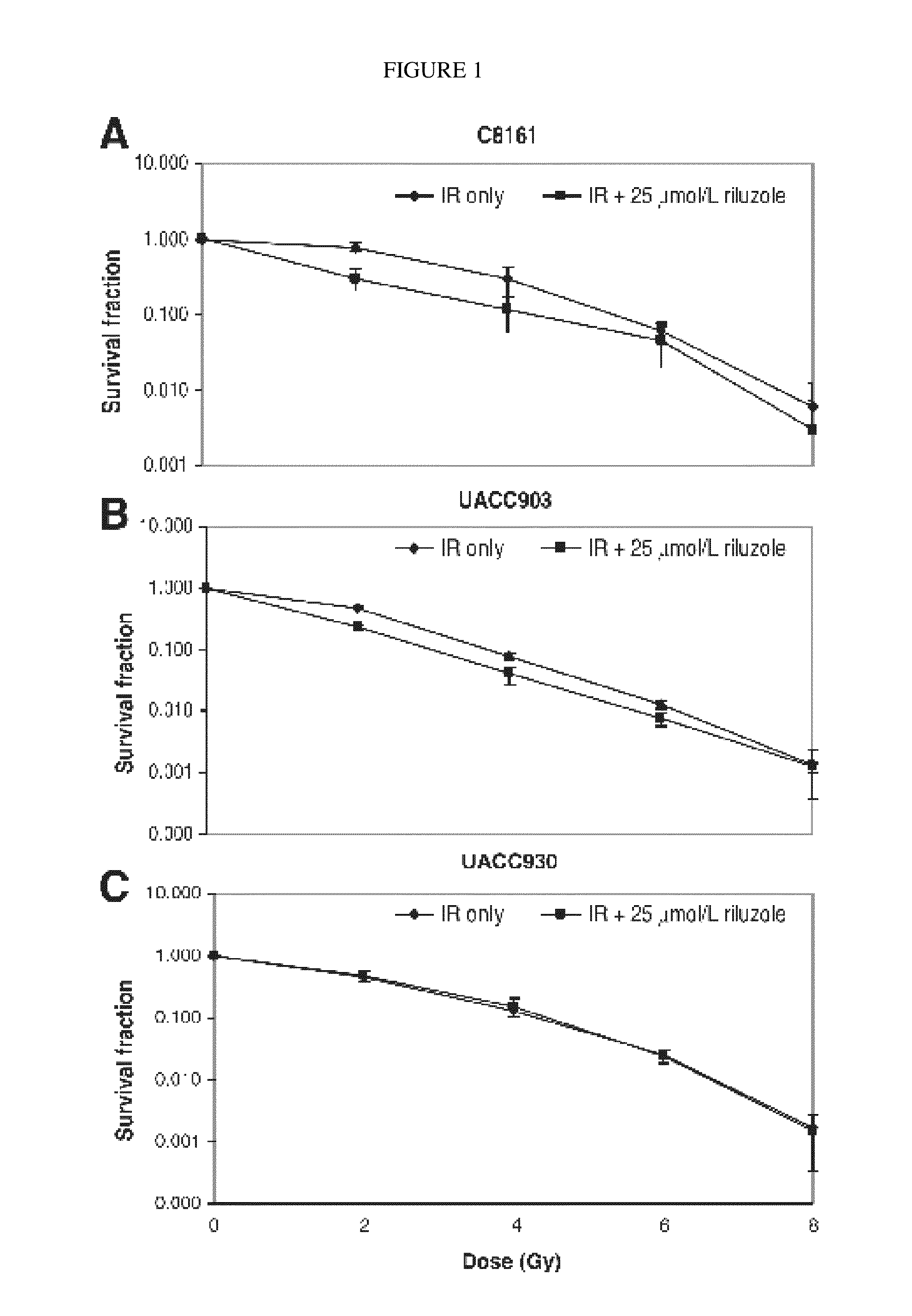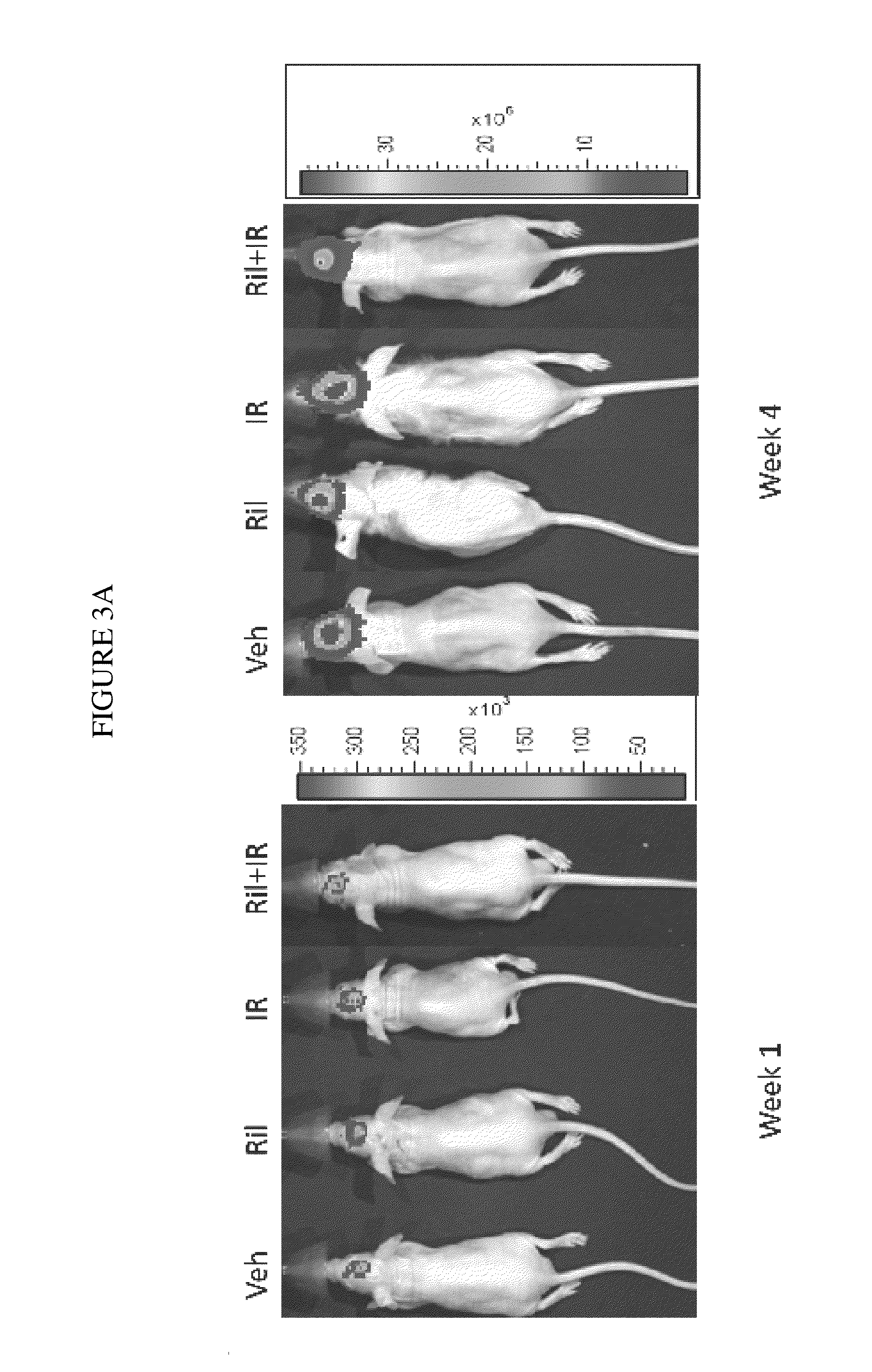Combination therapy using riluzole to enhance tumor sensitivity to ionizing radiation
a technology of ionizing radiation and combination therapy, which is applied in the field of combination therapy using riluzole to enhance tumor sensitivity to ionizing radiation, can solve the problems of limited success in combining systemic agents with wbrt to enhance the lethal effect of radiotherapy in melanoma patients, and the sensitivity of blastomas and metastatic melanomas to ionizing radiation is enhanced, and the effect of increasing radiation sensitivity
- Summary
- Abstract
- Description
- Claims
- Application Information
AI Technical Summary
Benefits of technology
Problems solved by technology
Method used
Image
Examples
example 1
Materials and Methods
Cell Lines
[0025]hGRM1-expressing C8161 [wild type (wt) for RAS and BRAF] and UACC903 (wt for RAS, mutated B-RAF, V600E) human melanoma cell line and hGRM1-negative melanoma cell line UACC930 (wt for RAS, mutated B-RAF, V600E), were obtained from Dr. Mary J. C. Hendrix (Children's Memorial Research Center, Chicago, Ill.) and Dr. Jeffrey M. Trent (Translational Genomics Research Center, Phoenix, Ariz.), respectively. Cells were cultured in monolayer at 37° C. in a 5% CO2 humidified incubator, in RPMI (InVitrogen) supplemented with 10% fetal bovine serum (Sigma).
Clonogenic Survival Assays
[0026]Cells were trypsinized for retrieval and plated on 100-mm plates and allowed to attach overnight for 20 hours. Riluzole (25 mmol / L) was added at the 20-hour time point and allowed to incubate for 24 hours. Drug concentration (25 mmol / L) was chosen on the basis of a 96-well plate ATP luminescence cell viability assay with increasing concentrations of drug in irradiated. Cells ...
example 2
Examination of Peritumoral Glutamate Levels Before and after Concurrent RT and RIL Using Advanced MR Spectroscopy in Phase I Patients
[0035]Paired pre- and post-therapy MR spectroscopy scans were obtained, evaluating glutamate levels in peritumoral edematous areas, allowing a non-invasive demonstration of the effect of the drug on the target. It is now understood that RIL treatment decreases the glutamate / creatine (Glu / Cr) ratio in paired, image-fused voxels within non-enhancing, T2 / FLAIR regions of the MRI. This represents a novel and powerful in-vivo method to demonstrate an intracranial drug effect.
example 3
Establishing a Primary Glioblastoma Xenograft Model in Zebrafish Using Cells Cultured from Primary Samples Obtained in Example 1
[0036]Glioblastoma exhibits genetic heterogeneity both within tumors and amongst patients. Thus it would be advantageous to add further therapeutic agents to the single-agent therapies, with or without RT, in order to achieve improvements in cure rates. Models that allow high throughput experimental drug testing offer the opportunity to identify novel compounds with anti-glioma activity. It is now understood that RT or the combination of RT / RIL induces specific “escape” responses in glioblastoma cells. The zebrafish model was utilized to identify additive / synergistic combination therapies with RT alone or RT / RIL and other candidate therapeutic agents.
PUM
| Property | Measurement | Unit |
|---|---|---|
| time | aaaaa | aaaaa |
| time | aaaaa | aaaaa |
| mean half life | aaaaa | aaaaa |
Abstract
Description
Claims
Application Information
 Login to View More
Login to View More - R&D Engineer
- R&D Manager
- IP Professional
- Industry Leading Data Capabilities
- Powerful AI technology
- Patent DNA Extraction
Browse by: Latest US Patents, China's latest patents, Technical Efficacy Thesaurus, Application Domain, Technology Topic, Popular Technical Reports.
© 2024 PatSnap. All rights reserved.Legal|Privacy policy|Modern Slavery Act Transparency Statement|Sitemap|About US| Contact US: help@patsnap.com










